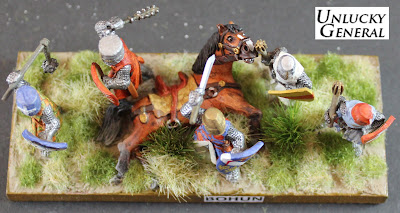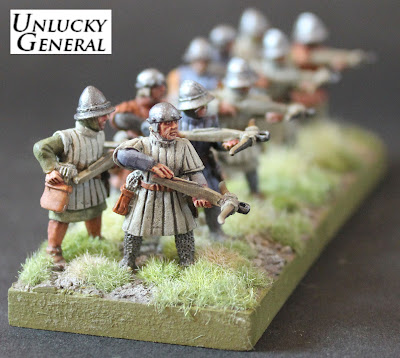FLAGS: To be or not to be
I'm currently finishing the painting of my latest unit of foot and have decided from this point to start making my armies flags. Each unit will have it's own flag to follow as logic and rules convention both dictate. My research has been revisited and at this time it may prove instructive to anyone dabbling in this specific period (mid-thirteenth century) to lay the ground rules for flags.
Whilst various flags abound throughout and originating from the medieval period, there are only two types permitted in an army for Lewes (1264). Whilst Standards, Pennons (or pendants), Banners and gonfalons, pinsels and guidons are all types of flags familiar to the wargamer of the broadly defined medieval period, we are only permitted Banners and Pennons.
PENNONS are perhaps the simplest to comprehend as they are the smaller, triangular flags attached to the end of a knight's lance for which every knight on the field was entitled to and may very well have carried. It was in fact during this period during the reign of Henry III that the pennon is first seen in its swallow tail form. It appears we can opt for simple equilateral triangle, swallow tail or even a scalene triangle form (cut from the 'hoist' or lance top of the pennon to the tail or 'fly').
Knights in our period are simply knights bachelor. This is the most ancient or oldest order of knights and the only type in existence for our period - later knights 'banneret' and specific orders of knights having yet to be created. Pennons do not necessarily carry the blazon or coat of arms if you will, and may have a badge or heraldic device only. So, in short, any member of the knightly class including earls may have such a flag. Incidentally, squires may carry smaller variants.
BANNERS do display the blazon or coat of arms of the knight as displayed on the shield and are square or rectangular. For me, this will be the unit flag taken from the knight who commands them. So, in a unit of mounted knights I may have any number of pennons streaming but only one banner. According to A Glossary of Terms Used in Heraldry (James Parker 1894) a banner was regulated in size according to rank. Regulation is understood to have been most likely in effect by our period but details I have found are only available from a later time (Henry VIII). Applying back to Lewes I will apply an earls banner at 3 feet square or 3 feet across the top of a rectangle perhaps as long at the hoist as 6 feet. A lesser knight (pretty well all other comers) is less - perhaps 2 feet square or similarly across the top in case of the rectangular.
Dimensions of the banner is another calculation I'm afraid. According to Parker, a pennon was half the length of a guidon which was one third shorter than the length of a standard (both of which post-date our period). Looking to the dimensions of standards of Scotland by fourteenth century, an earl had a standard of 13 feet and knights 10 feet. It is noted that an English knight had a standard 4 yards or 12 feet long. So, unless anyone has more specific information, I might just tack on +2 feet for an English earl. So my earl has a pennon 5 feet long - taken from standard of 15 feet and a guidon 10 feet long. Correspondingly my knight will have 4 foot long pennons.
If anyone has other ideas - I'm all ears.
Whilst various flags abound throughout and originating from the medieval period, there are only two types permitted in an army for Lewes (1264). Whilst Standards, Pennons (or pendants), Banners and gonfalons, pinsels and guidons are all types of flags familiar to the wargamer of the broadly defined medieval period, we are only permitted Banners and Pennons.
PENNONS are perhaps the simplest to comprehend as they are the smaller, triangular flags attached to the end of a knight's lance for which every knight on the field was entitled to and may very well have carried. It was in fact during this period during the reign of Henry III that the pennon is first seen in its swallow tail form. It appears we can opt for simple equilateral triangle, swallow tail or even a scalene triangle form (cut from the 'hoist' or lance top of the pennon to the tail or 'fly').
Knights in our period are simply knights bachelor. This is the most ancient or oldest order of knights and the only type in existence for our period - later knights 'banneret' and specific orders of knights having yet to be created. Pennons do not necessarily carry the blazon or coat of arms if you will, and may have a badge or heraldic device only. So, in short, any member of the knightly class including earls may have such a flag. Incidentally, squires may carry smaller variants.
BANNERS do display the blazon or coat of arms of the knight as displayed on the shield and are square or rectangular. For me, this will be the unit flag taken from the knight who commands them. So, in a unit of mounted knights I may have any number of pennons streaming but only one banner. According to A Glossary of Terms Used in Heraldry (James Parker 1894) a banner was regulated in size according to rank. Regulation is understood to have been most likely in effect by our period but details I have found are only available from a later time (Henry VIII). Applying back to Lewes I will apply an earls banner at 3 feet square or 3 feet across the top of a rectangle perhaps as long at the hoist as 6 feet. A lesser knight (pretty well all other comers) is less - perhaps 2 feet square or similarly across the top in case of the rectangular.
Dimensions of the banner is another calculation I'm afraid. According to Parker, a pennon was half the length of a guidon which was one third shorter than the length of a standard (both of which post-date our period). Looking to the dimensions of standards of Scotland by fourteenth century, an earl had a standard of 13 feet and knights 10 feet. It is noted that an English knight had a standard 4 yards or 12 feet long. So, unless anyone has more specific information, I might just tack on +2 feet for an English earl. So my earl has a pennon 5 feet long - taken from standard of 15 feet and a guidon 10 feet long. Correspondingly my knight will have 4 foot long pennons.
If anyone has other ideas - I'm all ears.



Comments